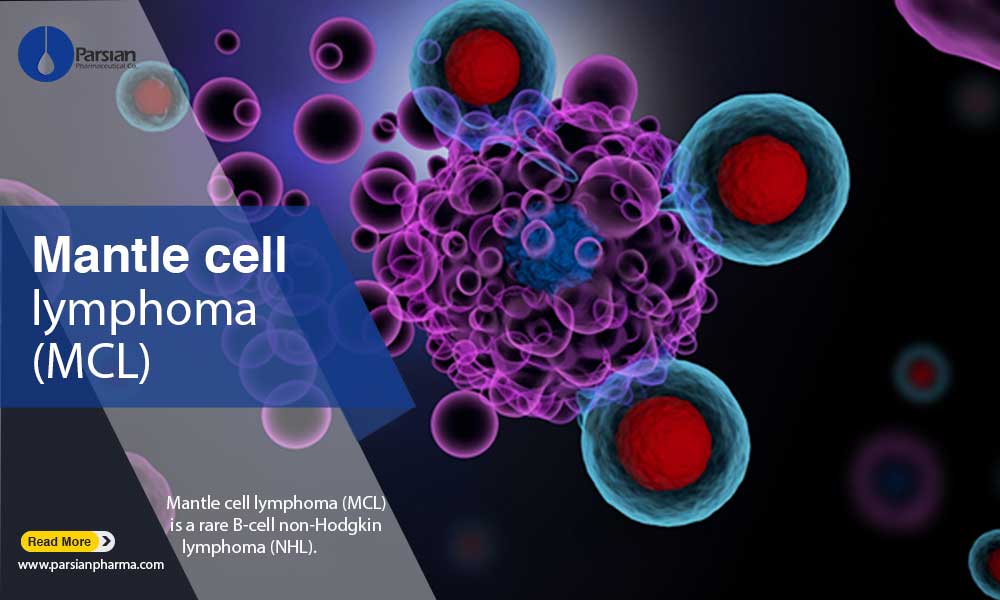Quick overview of Mantle cell lymphoma (MCL)
Mantle cell lymphoma (MCL) is grouped as one of the rare B-cell non-Hodgkin lymphoma (NHL). In non-Hodgkin lymphoma cancer, the lymphatic system is affected. About 6 to 8 percent of all NHLs are Mantle cell lymphoma (MCL).
This type of cancer is called “mantle cell lymphoma”, because the “mantle zone” of the lymph node is affected. MCL is a B-cell lymphoma that develops from malignant B-lymphocytes within the mantle zone of the lymph node. At first the disease progresses in more indolent manner but then it can be more aggressive over time.
MCL is usually diagnosed when cancer is at its late-stage; and is present in the bone marrow, other non-lymph node sites, bloodstream, and regions of the gastrointestinal tract.
This type of cancer is mostly seen between men who are usually 60 to 70 years old. According to estimations, about one out of 200,000 individuals per year are diagnosed with MCL.
Diagnosis of mantle cell lymphoma:
Sometimes MCL patients can be diagnosed during a routine blood test. The patients’ symptoms are depended on the extent of the disease and the region of the body that is affected. The most common test for diagnosing lymphoma is taking a sample of tissue from affected area, which the most common place to take a biopsy from is an enlarged lymph node. The tissue should be sent to a laboratory for testing. Doctors may also take biopsies from other areas of the body, like bowel.
This can be done during a test which is called colonoscopy. After taking biopsies, the collected tissue should be looked under a microscope.
Other tests of lymphoma cells are necessary to distinguish MCL from other subtypes of NHL, like routinely used panels of lymphocyte (immune cell) markers. And some tests like CT or PET/CT scan are necessary to determine what areas of the body are affected by the cancer.Sometimes, a biopsy of the bone marrow or endoscopy is done to help identify lymphoma that might not be diagnosed with scans.
More than 90 percent of MCL patients are associated with overproduction of a protein called cyclin D1 in the lymphoma cells. Detecting excess cyclin D1 from collected tissue, as well as a characteristic genetic mutation referred to as t (11;14) (q13;q32) translocation, are considered very sensitive tools for diagnosing MCL and providing prognostic information.
With testing for a protein called ki67, which increases in tumor tissue from lymph nodes when cells are preparing to divide, the clinicians can reach an idea about the proportion of lymphoma cells that are actively dividing.
Abnormalities in the T53 gene, which produces the p53 protein (the gatekeeper of cell division), can be associated with reduced responsiveness to some treatment options. And also, one out of four to one out of two MCL patients are associated with higher-than-normal levels of certain proteins that circulate in the blood, such as lactate dehydrogenase (LDH) and beta-2 microglobulin. By measuring these and other markers, physicians can find out how aggressive an individual patient’s MCL is and may guide therapy decisions.
Mantle cell lymphoma (MCL) stages:
MCL’s staging method is same as the other types of non-Hodgkin lymphoma, which is called the ANN ARBOR system. Parsian pharmaceutical Co has described it at its recent article.SLL
| Ann arbor Stageing classification for non-hodgkin Lymphomas | |
| stage 1 | involvement of single lymph node region (I) or of single extra lymphatic organ or site (IE) |
| stage 2 | involvement of 2 or more lymph node region or lymphatic structures on same side of diaphragm alone (ll) or with involvement of limited contiguous extra lymphatic organ or tissue (IIE) |
| stage 3 | involvement of lymph node regions on both sides of diaphragm (III, which may include spleen (IIIS) or limited contiguous extra lymphatic organ or site (IIIE) or both (IIIES) |
| stage 4 | Diffuse or disseminated foci of involvement of 1 or more extra lymphatic organs or tissues, with or without associated lymphatic involvement |
Treatment overview:
Mantle cell lymphoma (MCL) is generally considered an aggressive form of B-cell non-Hodgkin lymphoma; and most patients receive treatment following diagnosis and staging. However, small number of patients who have slow-growing MCL and are otherwise well, doctors may recommend a period of close observation, called “watchful waiting” for them. The doctor will schedule visits with these patients every 2 to 3 months, and do imaging tests every 3 to 6 months. If these patients become more prominent or there are signs of progression ;for example, increasing lymph node size, new pain symptoms or new enlarged nodes, the therapy should be begin.
Parsian pharmaceutical Co has been chose Ibrutinib, which is an oral inhibitor of Bruton tyrosine kinase; and is approved for patients with mantle cell lymphoma (MCL) who have received one prior therapy. And also can be used in the other types of blood cancer. These indication have been reviewed in Persian’s recent articles: HIGILIGHTS
related product :
Some of the main references that Parsian Pharmaceutical Co has observed :










